Golf course flyovers offer you a bird's-eye view of spectacular greens, providing breathtaking aerial footage that enhances your understanding and appreciation of course layouts. You'll see hidden hazards, strategic landing areas, and the natural beauty surrounding each hole. These soaring views, made possible by advanced drone technology, help you plan your shots and improve your game strategy. From showcasing signature holes to revealing dramatic elevation changes, flyovers have revolutionized golf broadcasting and course marketing. They've become an essential tool for players, designers, and viewers alike. Discover how these aerial perspectives are transforming the way you experience and approach the game of golf.
The Rise of Aerial Golf Footage

In recent years, golf enthusiasts have witnessed a revolution in how they experience courses from afar. Aerial golf footage has soared in popularity, offering you breathtaking views of some of the world's most stunning greens. This trend has been fueled by advancements in drone technology and high-definition cameras, making it easier and more affordable to capture sweeping shots of entire golf courses.
You'll find these flyovers on golf course websites, television broadcasts, and social media platforms. They're not just visually appealing; they're also practical. As a golfer, you can now scout courses before you play, gaining valuable insights into layout, hazards, and terrain.
Course designers and managers use these aerial views to showcase their work and attract new players. The rise of aerial golf footage has also changed how tournaments are covered. You're now treated to dramatic overhead shots that enhance your viewing experience, giving you a bird's-eye perspective of the action.
This technology has even influenced golf video games, allowing developers to create more realistic and immersive virtual courses for you to enjoy.
Drone Technology in Golf Broadcasting

Drone technology's impact on golf broadcasting has been nothing short of revolutionary. You'll now see stunning aerial shots that were once impossible or prohibitively expensive. These nimble devices can fly low over fairways, weave through trees, and hover mere feet above greens, offering you unprecedented views of the course.
You're no longer limited to static ground-level cameras or occasional blimp shots. Drones provide dynamic, real-time footage that enhances your understanding of hole layouts, hazards, and playing strategies. They're particularly useful for showcasing the undulations of greens and the subtle contours of fairways that traditional cameras often miss.
You'll notice that broadcasters are increasingly using drones for pre-tournament course flyovers, giving you a bird's-eye view of each hole. During live play, they're used for tracking shots, especially on long par-5s where ball flight can be difficult to follow.
Some tournaments even feature drone-captured 3D models of the course, allowing you to virtually explore every nook and cranny.
As drone technology advances, you can expect even more innovative uses in golf broadcasting, further immersing you in the action.
Capturing Course Layouts From Above
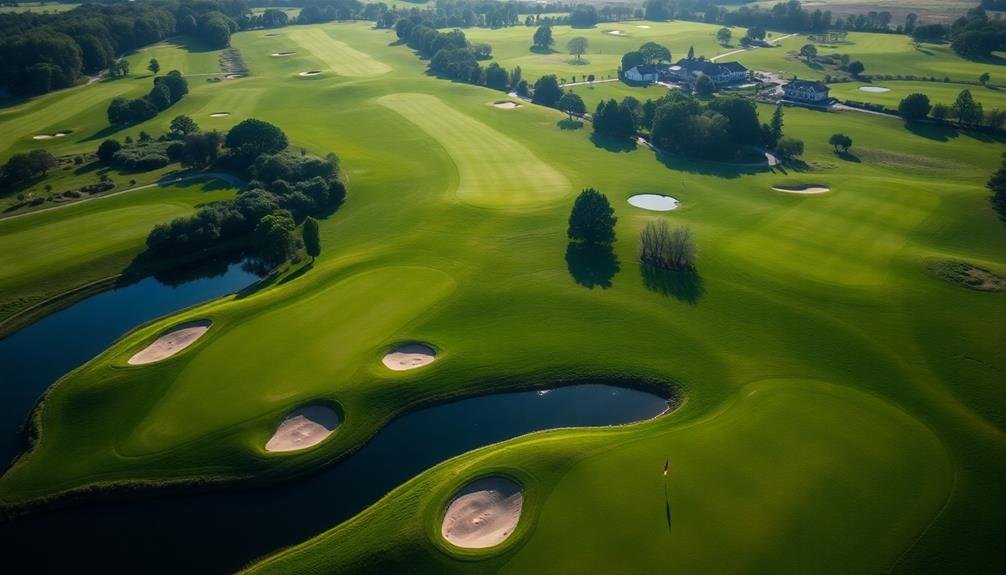
Capturing course layouts from above has become a game-changer for golf enthusiasts and professionals alike. You'll find that aerial footage provides a detailed view of the entire course, allowing you to see every fairway, hazard, and green in stunning detail. This bird's-eye perspective offers insights that simply aren't possible from ground level.
When you're planning your round, you can use these flyovers to strategize your approach to each hole. You'll spot hidden bunkers, water hazards, and undulations that mightn't be visible from the tee box.
Course designers and managers also benefit from this technology, as it helps them assess the layout, identify areas for improvement, and showcase their courses to potential players.
Modern drones equipped with high-resolution cameras capture these sweeping views with incredible clarity. They can fly at various altitudes, providing both expansive overviews and detailed close-ups of specific features.
You'll often see these flyovers incorporated into professional broadcasts, giving viewers at home a better understanding of the challenges faced by tournament players. It's a powerful tool that's revolutionizing how we experience and analyze golf courses.
Enhancing Player Strategy With Flyovers
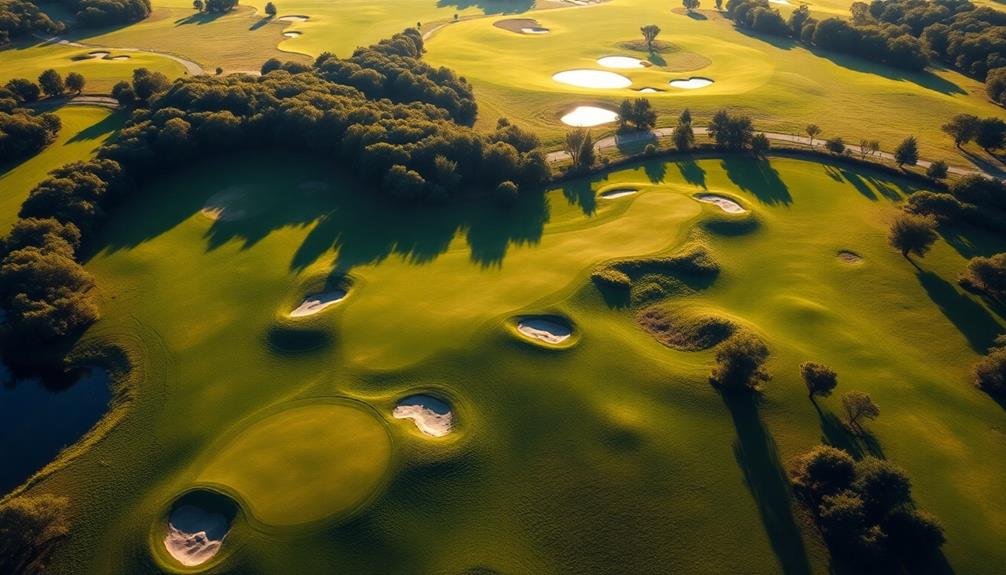
While course layouts provide a thorough view, flyovers truly excel at enhancing player strategy. You'll gain a unique perspective on each hole, allowing you to visualize your shots and plan your approach more effectively. Flyovers reveal subtle contours, hazards, and landing areas that mightn't be apparent from ground level.
As you watch a flyover, you'll see the best angles for tee shots and approaches. You can identify potential trouble spots and safe zones, helping you make smarter club selections. Flyovers also showcase the green complexes, giving you a better understanding of slopes and undulations. This knowledge can improve your putting strategy before you even step onto the green.
You'll also benefit from seeing how different holes connect and flow together. This broader perspective helps you manage your energy and focus throughout the round.
Flyovers can highlight strategic elements like risk-reward opportunities, allowing you to make informed decisions based on your playing style and skill level. By integrating flyover insights into your pre-round preparation, you'll approach each hole with more confidence and a clearer game plan.
Showcasing Scenic Golf Destinations
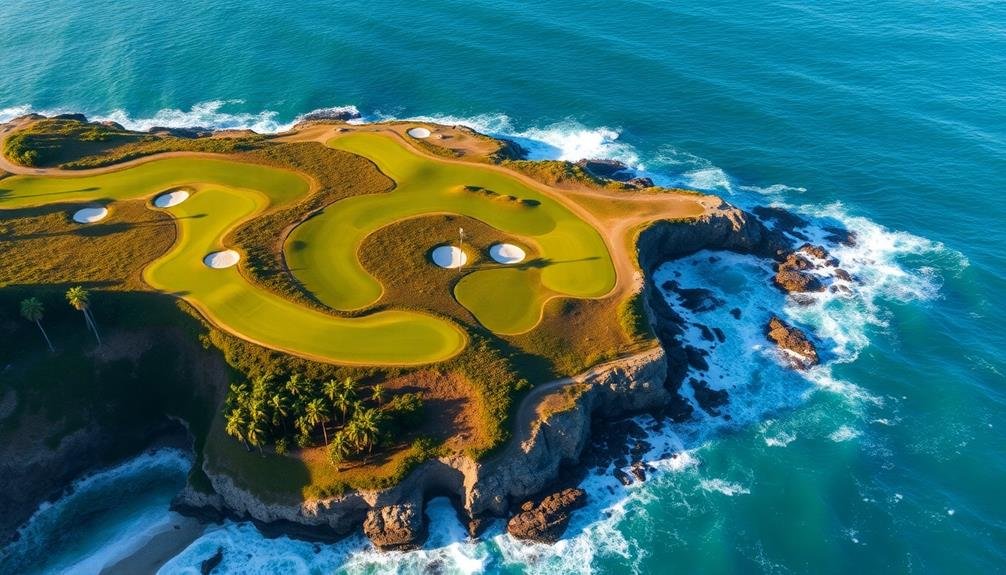
Beauty takes center stage when flyovers showcase scenic golf destinations. You'll experience breathtaking views of courses nestled in stunning landscapes, from coastal cliffs to mountain ranges.
These aerial tours highlight the natural splendor surrounding each hole, giving you a new appreciation for the course's design and its integration with the environment.
You'll see how designers have incorporated natural features like lakes, forests, and dunes into their layouts. Flyovers reveal hidden gems that mightn't be apparent from ground level, such as secluded greens or dramatic elevation changes.
They also capture the interplay of light and shadow across the course throughout the day, showcasing how the scenery transforms.
For destination golfers, these videos serve as enticing previews of potential travel spots. You can virtually explore courses around the world, from the rugged links of Scotland to the tropical paradises of Hawaii.
Flyovers help you prioritize your golfing bucket list by showcasing each course's unique charm and character. They also allow you to relive memorable rounds or dream about future trips, keeping your passion for golf alive even when you're far from the greens.
Aerial Shots for Course Marketing

Aerial shots can revolutionize your golf course marketing strategy.
You'll be able to showcase your course's entire layout, giving potential players a thorough view of what to expect.
These bird's-eye images also allow you to highlight unique features, such as signature holes, water hazards, or challenging bunkers, enticing golfers to experience your course firsthand.
Showcase Course Layout
Golf course marketing takes flight with stunning aerial shots that showcase the layout in all its glory. You'll captivate potential players with bird's-eye views that reveal the course's unique design and challenges. These aerial perspectives allow golfers to visualize their journey from tee to green, building excitement and anticipation.
Flyover videos and high-resolution images provide a thorough look at:
| Feature | Benefit | Impact |
|---|---|---|
| Hole layouts | Strategic planning | Improved game preparation |
| Hazard placements | Risk assessment | Enhanced decision-making |
| Fairway contours | Shot selection insights | Lower scores |
| Green complexes | Putting strategy | Increased confidence |
Highlight Unique Features
While showcasing the overall layout is important, aerial shots excel at highlighting your course's unique features. You'll want to capture those elements that set your course apart from others. Focus on signature holes, dramatic elevation changes, or picturesque water hazards that make golfers enthusiastic to play.
Use flyovers to showcase your course's natural beauty. Capture the interplay of sunlight on tree-lined fairways or the reflection of clouds in strategically placed ponds. Zoom in on meticulously maintained bunkers or uniquely shaped greens that challenge players' skills.
Don't forget to highlight man-made features too. Show off your clubhouse's architecture, inviting practice facilities, or scenic cart paths winding through the landscape.
If you have on-site amenities like restaurants or lodging, include those in your aerial tour to give potential visitors a complete picture of what to expect.
Challenges in Golf Course Filming

Filming golf courses from the air presents several unique challenges that videographers must overcome.
You'll need to navigate weather conditions carefully, as wind can destabilize your drone and affect image quality. Sunlight and shadows can create contrast issues, especially during early morning or late afternoon hours when many courses look their best.
You'll also face regulatory hurdles. Many golf courses are near airports or in restricted airspace, requiring special permissions or waivers. You must always respect players' privacy and avoid disrupting ongoing games.
Equipment limitations can pose problems too. Battery life constraints may restrict your filming time, while camera quality and stabilization are essential for professional results.
You'll need to master smooth flight patterns and camera movements to capture the course's flow effectively.
Timing is another challenge. You'll want to film when the course is in peak condition but not overly busy. This often means working within tight scheduling windows.
Lastly, you must understand golf course design and strategy to showcase each hole's unique features and challenges effectively. This knowledge will help you create compelling flyovers that truly capture the essence of the course.
Regulations for Drone Use

When using drones for golf course flyovers, you'll need to familiarize yourself with FAA regulations governing unmanned aircraft.
You should also check with the specific golf course for any local drone policies they've implemented.
It's essential to take into account safety and privacy issues, ensuring you don't disturb players or violate anyone's rights while capturing aerial footage.
FAA Rules for Drones
To operate drones for golf course flyovers, you'll need to comply with the Federal Aviation Administration's (FAA) regulations. First, register your drone if it weighs between 0.55 and 55 pounds. You must be at least 13 years old to register, and the registration is valid for three years.
For recreational use, follow the FAA's "The Recreational UAS Safety Test" (TRUST) guidelines. If you're flying for commercial purposes, you'll need to obtain a Remote Pilot Certificate by passing the Part 107 exam.
Keep your drone in visual line of sight at all times and fly below 400 feet. Don't fly over people or moving vehicles, and respect privacy. Avoid flying near airports or in restricted airspace without proper authorization.
Be aware of local regulations that may affect drone use on golf courses. Some courses may require permission or have specific rules for drone operations.
Weather conditions are vital; don't fly in adverse weather or when visibility is poor. Always yield the right of way to manned aircraft and never interfere with emergency response efforts.
Lastly, stay informed about updates to FAA regulations, as drone laws can change frequently.
Course-Specific Drone Policies
Many golf courses have implemented their own specific policies for drone use, supplementing FAA regulations. You'll find that these policies vary widely from course to course, so it's essential to check with each facility before planning a drone flight.
Some courses strictly prohibit all drone usage, citing privacy concerns for their patrons or potential disruptions to play. Others may allow drones but restrict them to certain areas or times, such as early mornings before tee times begin. You might encounter courses that require prior written permission, often involving a detailed flight plan and proof of insurance.
Certain golf clubs have embraced drone technology, permitting or even encouraging flyovers for promotional purposes or course mapping. These forward-thinking facilities may have designated takeoff and landing zones, as well as specific guidelines for altitude and distance from players.
When planning your golf course drone flight, always contact the course management in advance. Be prepared to provide your pilot credentials, drone specifications, and intended flight details.
Safety and Privacy Considerations
Safety and privacy considerations invariably top the list of concerns when flying drones over golf courses. You'll need to prioritize these issues to guarantee a smooth and legal flying experience.
First, always check local regulations and obtain necessary permits before launching your drone. Many areas have specific rules about where and when you can fly, especially near populated areas or private property.
When operating your drone, maintain a safe distance from golfers, staff, and spectators. You don't want to disturb play or risk injuring anyone. Keep your drone in sight at all times and avoid flying over people or vehicles.
Be aware of your surroundings, including trees, power lines, and buildings that could interfere with your flight.
Respect privacy by avoiding capturing images of individuals without their consent. Focus on the course's landscape and features rather than close-ups of players or staff. If you're planning to share or publish your footage, guarantee you have the golf course's permission.
Lastly, consider weather conditions before flying. Strong winds, rain, or extreme temperatures can affect your drone's performance and safety.
Equipment for Golf Course Flyovers

Choosing the right equipment is vital for successful golf course flyovers. You'll need a reliable drone capable of capturing high-quality aerial footage. Look for models with 4K video capabilities and good image stabilization to guarantee smooth, professional-looking results.
Consider drones with longer flight times and extended range to cover larger courses without interruption. Your drone should have a high-quality camera with adjustable settings. This will allow you to capture the course in various lighting conditions and adjust for different times of day.
Don't forget to invest in extra batteries and memory cards to maximize your shooting time. A tablet or smartphone with a large, bright screen is essential for monitoring your drone's feed and controlling its flight path.
You'll also need a sturdy carrying case to protect your equipment during transport. For post-production, invest in video editing software to enhance your footage. This will help you create polished flyover videos that showcase the course's best features.
Lastly, consider accessories like ND filters to manage bright sunlight and propeller guards for added safety during flight.
Post-Production Techniques for Aerial Footage

Once you've captured your aerial footage, it's time to transform it into a stunning golf course flyover video. Post-production techniques are essential for enhancing the raw footage and creating a polished final product.
Start by importing your footage into professional video editing software. Stabilize shaky shots and color-correct your clips to guarantee consistency throughout the video.
Next, add graphics and text overlays to highlight key course features, hole numbers, and yardages. You can also incorporate course logos and branding elements to give the video a professional touch. Consider using slow-motion effects for dramatic shots of water hazards or sand traps.
To create a seamless flyover experience, you'll want to:
- Trim and arrange your clips in a logical sequence, following the course layout
- Add smooth shifts between holes to maintain flow
- Include a dynamic intro and outro to bookend your video
Don't forget to add a suitable soundtrack that complements the visuals without overpowering them.
Integrating Flyovers With Live Coverage
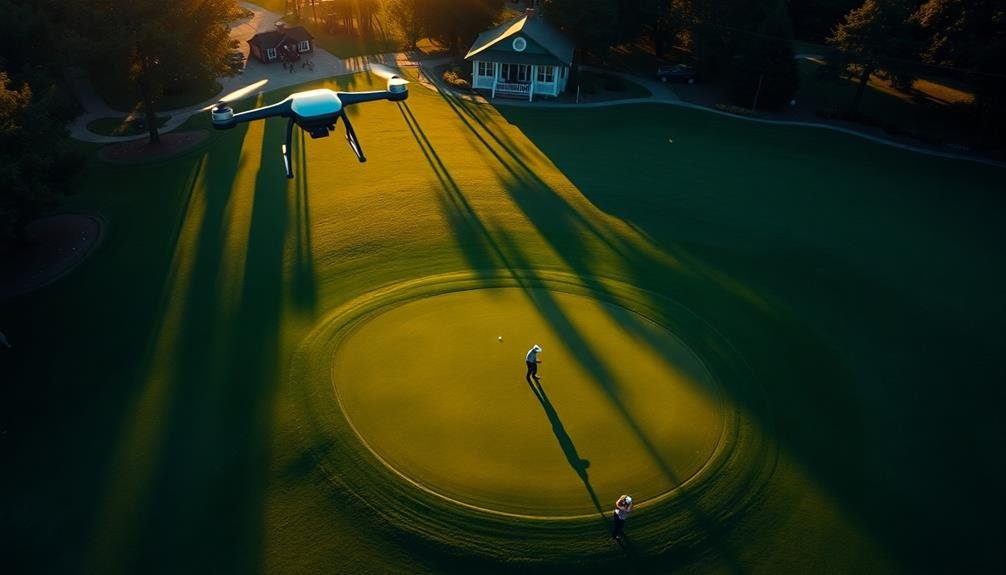
While post-production techniques enhance pre-recorded flyovers, integrating these aerial shots with live golf coverage adds a new dimension to broadcasts.
You'll find that timing is essential when incorporating flyovers into live events. Producers must seamlessly blend these aerial views with on-ground footage, ensuring they don't disrupt the flow of play or miss critical moments.
To achieve this integration, you'll need a well-coordinated team. Your drone operators must be in constant communication with the production crew, ready to capture and transmit footage at a moment's notice.
You'll also want to use advanced broadcasting software that allows for quick shifts between live action and pre-recorded flyovers.
Consider using flyovers during natural breaks in play, such as between holes or while players are walking to their next shot.
You can also overlay live scoring information or player stats on these aerial views, providing viewers with a thorough understanding of the course layout and current tournament standings.
Future of Golf Course Cinematography
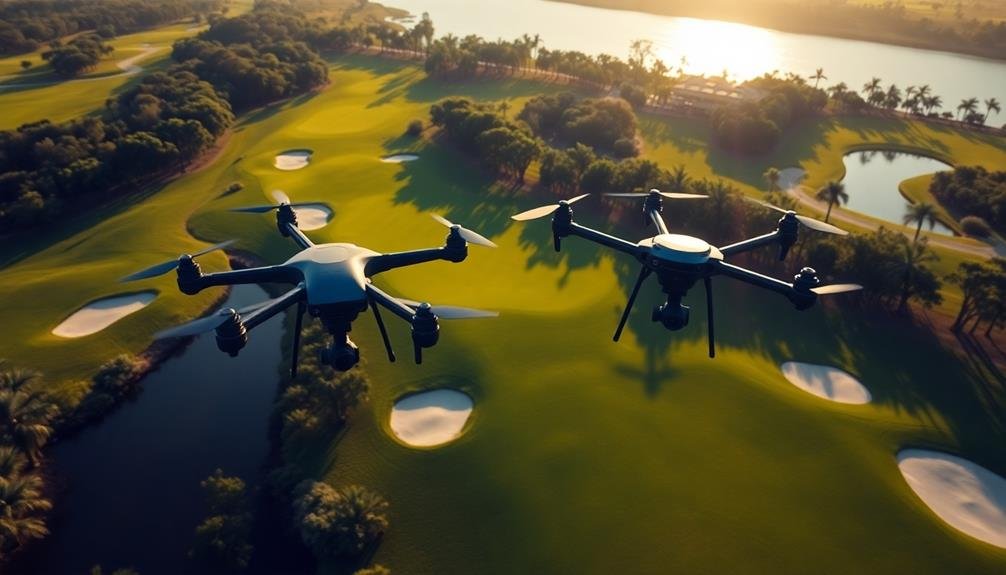
The future of golf course cinematography is poised for exciting advancements. You'll soon witness a revolution in how golf courses are captured and presented to viewers.
Cutting-edge technologies like 8K resolution cameras, artificial intelligence, and virtual reality will transform the way you experience golf courses from afar.
Imagine donning a VR headset and instantly transporting yourself to the world's most prestigious courses. You'll be able to walk the fairways, study the greens, and feel as if you're actually there.
AI-powered cameras will track players and balls with unprecedented accuracy, providing real-time data and analytics that enhance your understanding of the game.
Here's what you can look forward to in golf course cinematography:
- Drone swarms that capture multiple angles simultaneously
- Holographic replays of iconic shots and moments
- Interactive 3D course maps that you can explore in real-time
These innovations won't only elevate the viewing experience for golf enthusiasts but also provide valuable tools for players and course designers.
As technology continues to evolve, you'll find yourself more immersed in the beauty and strategy of golf courses than ever before.
Frequently Asked Questions
How Much Does a Professional Golf Course Flyover Video Typically Cost?
You'll typically spend between $2,000 to $5,000 for a professional golf course flyover video. Costs can vary based on course size, video length, and production quality. Higher-end productions may reach $10,000 or more for premium results.
Can Amateur Drone Pilots Create High-Quality Golf Course Flyover Footage?
You can create high-quality golf course flyover footage as an amateur drone pilot. It'll take practice, good equipment, and knowledge of regulations. Focus on smooth movements, interesting angles, and editing skills to produce professional-looking results.
Are There Any Golf Courses That Prohibit Aerial Filming?
Yes, many golf courses prohibit aerial filming. You'll find that private clubs and high-profile courses often have strict policies against drones. It's essential to check with the course management before attempting any aerial photography or videography.
How Long Does It Take to Film a Complete 18-Hole Course Flyover?
You'll typically need 4-6 hours to film a complete 18-hole course flyover. It depends on factors like course layout, weather conditions, and the level of detail you're capturing. Don't forget to account for setup time too.
Do Golf Course Flyovers Impact Wildlife or Disrupt Players During Tournaments?
You'll find that golf course flyovers can disturb wildlife if not carefully planned. They're typically done outside tournament hours to avoid disrupting players. Operators must follow local regulations to minimize environmental impact and respect the game.
In Summary
You've seen how golf course flyovers are revolutionizing the sport's visual presentation. They're not just eye candy; they're changing how you experience and understand the game. As drone technology advances, you'll witness even more stunning aerial footage. Whether you're a player analyzing course strategy or a fan marveling at scenic landscapes, these soaring views are here to stay. Get ready for golf cinematography to reach new heights, enhancing your viewing pleasure for years to come.

As educators and advocates for responsible drone use, we’re committed to sharing our knowledge and expertise with aspiring aerial photographers.
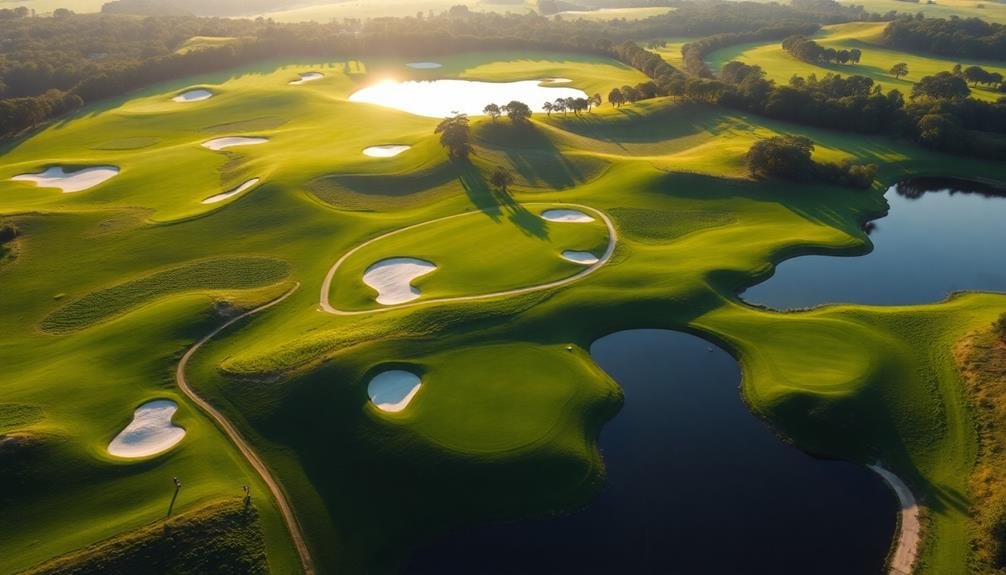



Leave a Reply